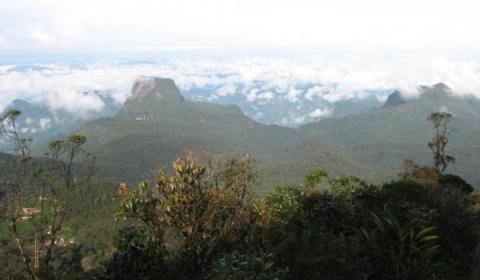Enhancing education and awareness on the Central Highlands
Project title: Enhancing education and awareness on the Central Highlands, a UNESCO World Heritage Serial Property in Sri Lanka
Location:
The Central Highlands is a serial property comprising of three component parts: Peak Wilderness Nature Reserve, Horton Plains National Park and Knuckles Conservation Forest. The Peak Wilderness Nature Reserve extends across three districts; Nuwara Eliya in the Central Province, and Rathnapura and Kegalle in the Sabaragamuwa Province. Horton Plains National Park is located in the Nuwara Eliya district in the Central Province. The Knuckles Conservation Forest is located in the Matale and Kandy districts in the Central Province.
Duration: August 2015 to August 2018
Project Background:
The Central Highlands of Sri Lanka was inscribed as a World Heritage Serial Property of UNESCO in August 2010. The serial property consists of three components viz. Knuckles Conservation Forest (KCF), Horton Plains National Park (HPNP) and Peak Wilderness Protected Area (PWPA). The PWPA consists of four components viz. Peak Wilderness Nature Reserve, Peak Wilderness Conservation Forest, Morahela and Walawe Basin Conservation Forests.
Central Highlands World Heritage Serial Property (CHWHS) is the second such UNESCO recognized natural world heritage in Sri Lanka after the Sinharaja Forest reserve. Administratively, the KCF and the conservation forests in the PWPA fall within the purview of the Forest Department and are managed under the provisions of the Forest Ordinance. The rest of the constituents are managed by the Department of Wildlife Conservation, under jurisdiction of the Fauna and Flora Protection Ordinance.
The high biodiversity, high degree of endemism and presence of rare and endangered species in this property is a significant indicator of its universal value, which has to be protected along with its integrity or ‘wholeness’ to retain its values for generations. In addition to those universal values, CHWHS is immensely valuable locally for its watershed services and recreational values.
As the focal agency for UNESCO’s World Heritage Commission in Sri Lanka, the Ministry of Environment (MoE) has taken the initiative in developing a visitor management plan together with the Department of Wildlife Conservation and Forest Department for the CHWHS. One of the needs identified by this initiative is the lack of educational, awareness and interpretation materials on the CHWHS. This project—supported under HSBC’s 150th Anniversary Grant—will facilitate the production of a series of resource materials on each component of the world heritage site, which will ultimately contribute to better management and conservation of these areas.
IUCN, in close consultation and partnership with MoE, FD and DWC will prepare resource, awareness and interpretation materials targeting local visitors, international visitors and other stakeholders. These professionally developed resource materials will link the key three segments into one platform for the sustainable management of the sites.
Developing these awareness materials will also raise awareness of CHWHS amongst the local community, including school children and managers of the sites who need to learn about the long-term conservation and wise use of the World Heritage Site.
Objectives of the project:
- Preparation of a series of resource and awareness materials to be used by wider stakeholders who play a key role in sustainable management of the site.
- Identify awareness gaps and main requirements/needs within the three main sites (HPNP, PWNR, and KFR).
- Preparation of dissemination materials at different levels (local and international visitors, students, planters and managers) for the three main sites.
- Disseminate information through relevant channels.
Expected Outputs:
- Descriptive guide
- Visitor/trekking guide
- Information brochure
- Posters
- Teacher training workshops
Donor: HSBC 150th Anniversary Grant
Partners: Forest Department and Department of Wildlife Conservation

